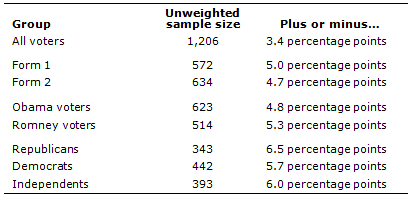The analysis in this report is based on telephone interviews conducted November 8-11, 2012 among a national sample of 1,206 voters (“Voters” are those who said they voted in the 2012 election). The interviews were conducted among registered voters, 18 years of age or older, previously interviewed in a Pew Research survey conducted of 3,151 registered voters October 31-November 3, 2012 (for more about the methodology of the original survey, see here). Interviews were conducted on both landline telephones and cell phones (760 respondents for this survey were interviewed on a landline telephone, and 446 were interviewed on a cell phone, including 189 who had no landline telephone). The survey was conducted by interviewers at Princeton Data Source under the direction of Princeton Survey Research Associates International. Interviews were conducted in English and Spanish. Interviewers asked to speak with the respondent from the previous interview by first name, if it was available, or by age and gender.
The weighting was accomplished in multiple stages. The first stage used the respondents’ final weight from the original survey to correct for any biases in that survey. In the second stage, the sample was weighted using an iterative technique that matches gender, age, education, race, Hispanic origin and nativity and region to targets for all registered voters eligible for re-contact from the original survey. This step helps to minimize bias that could occur because certain types of respondents may have been easier or more difficult to re-interview. In addition, the sample was weighted to reflect the margin of the 2012 election results (an approximately 3-point Obama advantage over Romney). Sampling errors and statistical tests of significance take into account the effect of weighting. The following table shows the unweighted sample sizes and the error attributable to sampling that would be expected at the 95% level of confidence for different groups of voters in the survey:

Sample sizes and sampling errors for other subgroups are available upon request.
In addition to sampling error, one should bear in mind that question wording and practical difficulties in conducting surveys can introduce error or bias into the findings of opinion polls.




